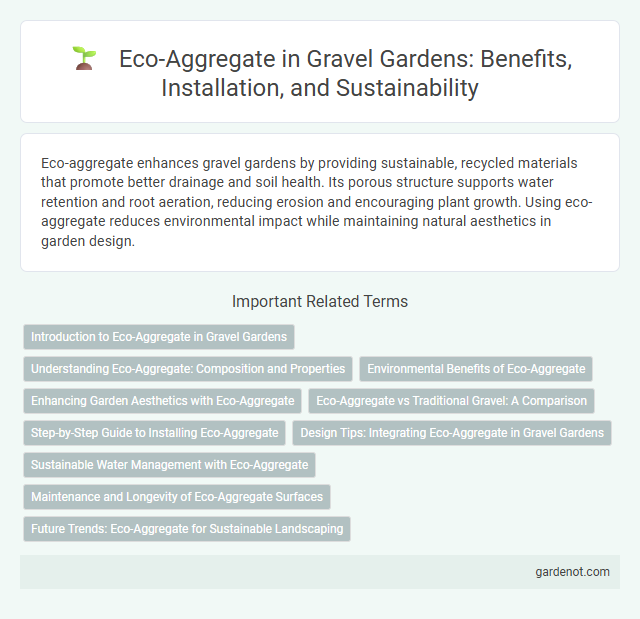Eco-aggregate enhances gravel gardens by providing sustainable, recycled materials that promote better drainage and soil health. Its porous structure supports water retention and root aeration, reducing erosion and encouraging plant growth. Using eco-aggregate reduces environmental impact while maintaining natural aesthetics in garden design.
Introduction to Eco-Aggregate in Gravel Gardens
Eco-aggregate in gravel gardens enhances soil permeability and promotes sustainable drainage by utilizing recycled materials such as crushed concrete and reclaimed stone. This environmentally friendly alternative to traditional aggregate supports plant health by improving aeration and moisture retention while reducing the need for chemical treatments. Incorporating eco-aggregate preserves natural ecosystems by minimizing resource extraction and lowering carbon footprints in garden landscaping.
Understanding Eco-Aggregate: Composition and Properties
Eco-aggregate consists primarily of recycled materials such as crushed concrete, brick, and natural stone, offering an environmentally friendly alternative to traditional aggregates. Its porous structure enhances drainage and reduces surface runoff, making it ideal for sustainable gravel garden designs. Understanding the composition and physical properties of eco-aggregate aids in selecting the right mix for durability, permeability, and aesthetic appeal in eco-conscious landscaping projects.
Environmental Benefits of Eco-Aggregate
Eco-aggregate, produced from recycled construction and demolition waste, significantly reduces the demand for natural gravel, preserving natural landscapes and reducing habitat disruption. Its use minimizes landfill waste, lowers carbon emissions associated with raw material extraction, and promotes sustainable construction practices. By integrating eco-aggregate in gravel gardens, water drainage improves naturally, supporting soil health and local biodiversity.
Enhancing Garden Aesthetics with Eco-Aggregate
Eco-aggregate enhances garden aesthetics by providing a sustainable and visually appealing ground cover that mimics natural stone textures while promoting soil health. This eco-friendly material improves drainage and reduces weed growth, creating a clean, low-maintenance landscape ideal for gravel gardens. Incorporating eco-aggregate supports environmental conservation efforts and adds a unique, textured look that complements both modern and rustic garden designs.
Eco-Aggregate vs Traditional Gravel: A Comparison
Eco-aggregate offers superior environmental sustainability compared to traditional gravel by utilizing recycled materials and reducing the demand for natural stone extraction. Its porous structure enhances drainage and prevents soil erosion, making it ideal for eco-conscious landscaping projects. Unlike conventional gravel, eco-aggregate often provides improved longevity and lower carbon footprints, aligning with green garden initiatives.
Step-by-Step Guide to Installing Eco-Aggregate
Eco-aggregate installation begins with site preparation, ensuring proper grading and drainage to prevent water pooling. Lay a geotextile membrane to suppress weeds and stabilize the base, then evenly spread the eco-aggregate material, compacting it in layers for durability. Final steps involve edging installation to contain the aggregate and flushing the surface to remove fine particles, enhancing visual appeal and longevity.
Design Tips: Integrating Eco-Aggregate in Gravel Gardens
Eco-aggregate enhances gravel garden design by improving drainage and reducing soil erosion while maintaining an eco-friendly footprint. Incorporate varying sizes and colors of eco-aggregate to create textured pathways and visual interest, ensuring sustainable material sources for environmental benefits. Position eco-aggregate around drought-resistant plants to optimize water conservation and support healthy root systems in low-maintenance garden layouts.
Sustainable Water Management with Eco-Aggregate
Eco-aggregate in gravel gardens enhances sustainable water management by improving soil permeability and reducing runoff. Its porous structure facilitates efficient water infiltration and retention, promoting healthier plant growth while minimizing erosion. Utilizing eco-aggregate supports environmental conservation by optimizing natural water cycles in landscaped areas.
Maintenance and Longevity of Eco-Aggregate Surfaces
Eco-aggregate surfaces in gravel gardens require minimal maintenance due to their durability and resistance to erosion, reducing the need for frequent repairs or replenishment. Their composition allows efficient water drainage, preventing pooling and preserving structural integrity over time. This longevity ensures sustainable garden paths and beds, enhancing both functionality and aesthetic appeal with lower environmental impact.
Future Trends: Eco-Aggregate for Sustainable Landscaping
Eco-aggregate, derived from recycled materials and industrial by-products, represents a significant innovation in sustainable landscaping, offering enhanced durability and reduced environmental impact compared to traditional aggregates. Future trends emphasize its integration into gravel gardens to promote water conservation, soil health, and biodiversity through improved permeability and nutrient retention. Increasing adoption of eco-aggregate aligns with global sustainability goals, supporting resilient ecosystems and reducing urban heat island effects in landscape design.
Eco-aggregate Infographic

 gardenot.com
gardenot.com